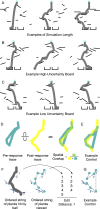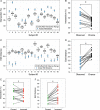Behavioral and oculomotor evidence for visual simulation of object movement
- PMID: 31185095
- PMCID: PMC6559752
- DOI: 10.1167/19.6.13
Behavioral and oculomotor evidence for visual simulation of object movement
Abstract
We regularly interact with moving objects in our environment. Yet, little is known about how we extrapolate the future movements of visually perceived objects. One possibility is that movements are experienced by a mental visual simulation, allowing one to internally picture an object's upcoming motion trajectory, even as the object itself remains stationary. Here we examined this possibility by asking human participants to make judgments about the future position of a falling ball on an obstacle-filled display. We found that properties of the ball's trajectory were highly predictive of subjects' reaction times and accuracy on the task. We also found that the eye movements subjects made while attempting to ascertain where the ball might fall had significant spatiotemporal overlap with those made while actually perceiving the ball fall. These findings suggest that subjects simulated the ball's trajectory to inform their responses. Finally, we trained a convolutional neural network to see whether this problem could be solved by simple image analysis as opposed to the more intricate simulation strategy we propose. We found that while the network was able to solve our task, the model's output did not effectively or consistently predict human behavior. This implies that subjects employed a different strategy for solving our task, and bolsters the conclusion that they were engaging in visual simulation. The current study thus provides support for visual simulation of motion as a means of understanding complex visual scenes and paves the way for future investigations of this phenomenon at a neural level.
Figures





References
-
- Ballard D. H, Hayhoe M. M, Pook P. K, Rao R. P. Deictic codes for the embodiment of cognition. Behavioral and Brain Sciences. (1997);20(4):723–767. - PubMed
-
- Banca P, Sousa T, Duarte I. C, Castelo-Branco M. Visual motion imagery neurofeedback based on the hMT+/V5 complex: Evidence for a feedback-specific neural circuit involving neocortical and cerebellar regions. Journal of Neural Engineering. (2015);12(6):066003. doi: 10.1088/1741-2560/12/6/066003. - DOI - PubMed
Publication types
MeSH terms
Grants and funding
LinkOut - more resources
Full Text Sources

